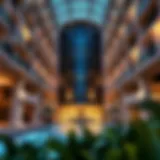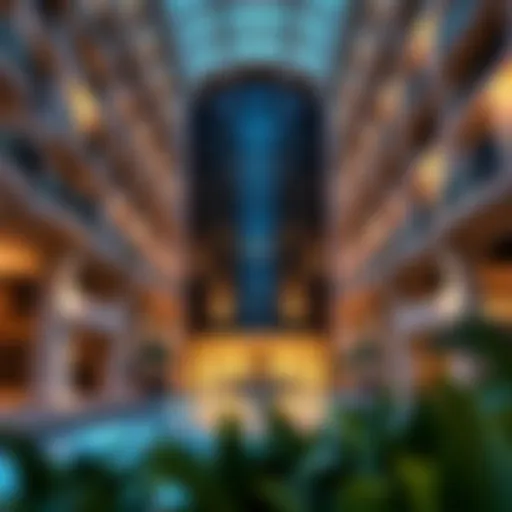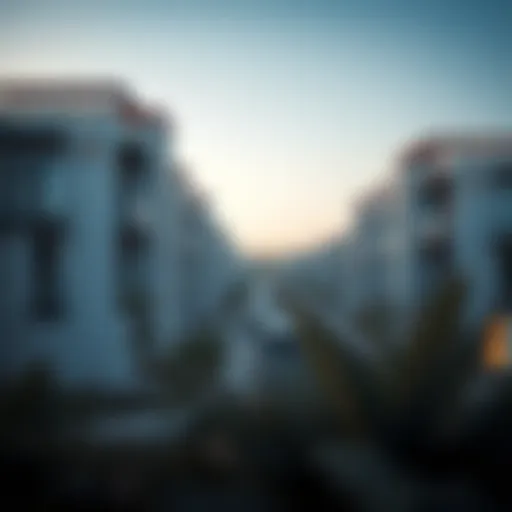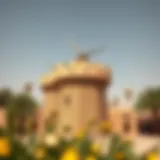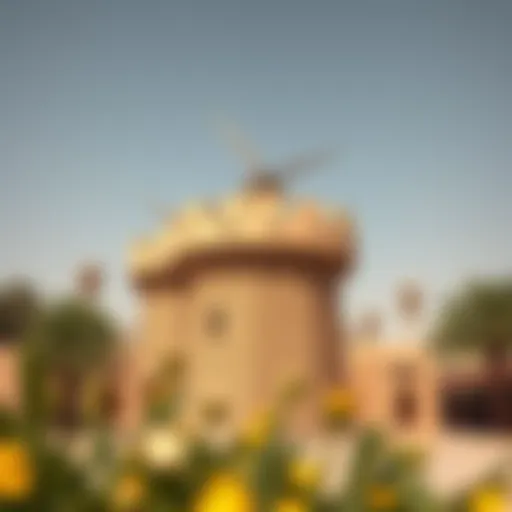Aldar Sustainable City: A Deep Dive into Innovation
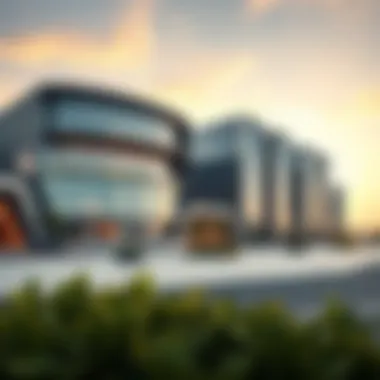

Intro
Aldar Sustainable City stands as a beacon of progress in the realm of urban planning and environmental stewardship. Nestled in the United Arab Emirates, this ambitious project is not merely a cluster of buildings; it embodies a pioneering vision for sustainable living. The aspirations of Aldar Sustainable City stretch beyond just architectural innovation; it seeks to reshape how communities interact with their environment. Here, in this comprehensive overview, we'll navigate through its intricacies—from the underlying design philosophy to the economic implications and social dynamics that shape this vibrant community.
It’s clear that this isn’t just another throw of the dice in urban development. Rather, Aldar Sustainable City’s approach integrates principles that address real-world challenges, allowing for an environmentally responsible habitat while promoting community engagement. This synthesis of ecological mindfulness with economic rationality makes it a notable reference point for any stakeholders in the investing, buying, or developmental spheres.
Throughout this article, we will delve into several key aspects:
- Architectural and ecological features that define Aldar Sustainable City
- Current trends in the property market surrounding the area
- Detailed guidelines for those interested in buying or selling property within the city
- How the city fosters a sense of community among its residents
As we journey through these themes, the aim is to provide insights that will aid investors, buyers, agents, developers, and sellers in understanding not just the market, but the holistic picture of what Aldar Sustainable City represents.
Let’s kick things off with a thorough look at the property market landscape in Aldar Sustainable City, focusing on trends and neighborhood insights.
Foreword to Aldar Sustainable City
Aldar Sustainable City stands as a beacon of modern urban planning, emphasizing environmental responsibility while meeting the needs of its inhabitants. Understanding this concept is crucial, not just for those directly invested in the project, but for society at large. The significance of Aldar goes beyond its architectural beauty; it’s a statement that urban development can coexist harmoniously with nature.
Historical Context
To truly appreciate Aldar Sustainable City, one must grasp the historical context surrounding its conception. The United Arab Emirates has long been characterized by rapid development and a transformative economic landscape that merely decades ago was driven primarily by oil. As the world has shifted towards sustainability and environmental awareness, the UAE has begun to rethink its urban strategies. This led to the genesis of Aldar, a city designed to transcend traditional models of urbanisation. In many ways, Aldar reflects a response to the pressures of climate change and the need for sustainable living solutions. The planners took cues from varying international models of eco-friendly cities while intertwining local culture and practices. Thus, the city embodies a true fusion of global perspective and regional identity.
A Vision for Sustainable Development
Aldar's ambition doesn’t stop at reducing carbon footprints and innovating architectural design; it's about creating a sustainable urban ecosystem. The vision is anchored on several key pillars:
- Economic viability: Investing in renewable resources and efficient systems means long-term savings, creating an alluring proposition for investors.
- Environmental integrity: Utilizing green spaces, preserving biodiversity, and minimizing waste are focal points. This is not just for aesthetics but for creating a community that values its natural surroundings.
- Social sustainability: Engaging local communities ensures that development meets the needs of residents, fostering a sense of belonging and shared responsibility.
The success of such initiatives often rests on local involvement. To ensure that this vision is not just paper promises, Aldar actively implements educational programs, encouraging residents to not only participate in sustainability efforts but to advocate them. As such, Aldar Sustainable City is not merely a project—it’s a comprehensive blueprint for a better future rooted in collaboration, innovation, and responsibility.
“Aldar represents an ideal where every element is a cog guiding us towards a more sustainable world.”
Architectural Design Principles
Architectural design principles serve as the backbone of Aldar Sustainable City, illuminating how form, function, and sustainability intertwine to create a modern urban landscape. The significance of these principles cannot be overstated, especially in a project that aims to set benchmarks for ecological responsibility and urban livability. This section unpacks the various aspects of architectural design within the context of the city, highlighting innovative approaches, sustainable materials, and the integration of natural elements, each contributing to a holistic vision of sustainability.
Innovative Use of Space
Utilizing space efficiently is a cornerstone of Aldar’s design philosophy. The layout of the city is meticulously planned to ensure that every square meter serves a purpose, combining residential, commercial, and recreational areas in a way that maximizes interaction and minimizes congestion.
Key features of this innovative approach include:
- Mixed-Use Developments: By incorporating apartments, offices, and retail spaces into a single complex, Aldar reduces the need for transport and encourages a vibrant community atmosphere.
- Flexible Floor Plans: These allow for quick adaptations to changing needs, making it easier for businesses to thrive without extensive renovations.
- Public Spaces: Attention is given to parks and community hubs that offer areas for recreation, fostering social interaction and promoting a healthy lifestyle.
With these concepts, Aldar Sustainable City is not just building structures; it is crafting an experience that resonates with modern life while also addressing environmental concerns.
Sustainable Materials and Construction
The choice of materials directly influences the sustainability of any urban project. In the case of Aldar Sustainable City, there is a committed focus on sourcing green building materials that not only minimize environmental impact but also enhance energy efficiency.
Some notable considerations include:
- Recycled and Locally Sourced Materials: Using materials that have been repurposed or sourced nearby decreases the carbon footprint related to transportation and resource extraction.
- Energy-Efficient Technologies: Advanced insulation techniques and smart glass reduce energy demands, lowering utility costs and enhancing comfort for residents.
- Durable Construction Practices: Long-lasting materials and construction methods ensure that buildings withstand the tests of time, reducing the need for frequent repairs or replacements.
Ultimately, these sustainable choices reflect a conscientious effort toward building an eco-friendly urban environment that aligns with global sustainability goals.
Integration with Natural Elements
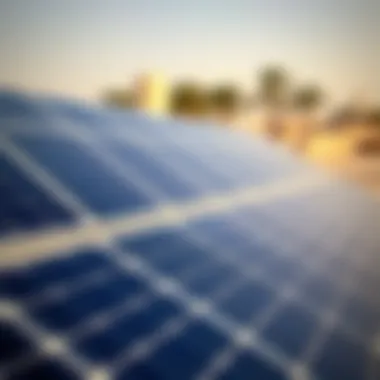

One of the hallmarks of Aldar Sustainable City is its effort in harmonizing urban living with nature. This integration goes beyond mere aesthetics; it is about creating a synergistic relationship that benefits both residents and the environment.
Several strategies contribute to this integration:
- Green Roofs and Walls: These not only enhance the visual appeal but also improve air quality and reduce heat absorption, providing cooler microclimates in cities.
- Water Features: Incorporating lakes, ponds, and artificial streams enhances biodiversity while aiding in local climate regulation.
- Landscaped Pathways: Pedestrian-friendly designs with ample green spaces encourage walking and cycling, promoting healthier lifestyle choices while reducing vehicle reliance.
"In Aldar Sustainable City, nature isn't just a backdrop; it's an integral actor in the urban story, enhancing life quality and reducing environmental impact."
By prioritizing these design principles, Aldar Sustainable City distinguishes itself as a model of modern urban planning, demonstrating how design can blend functionality with sustainability in a way that meets the needs of today while respecting the environment for tomorrow.
For further reading about sustainable urban design principles, visit Wikipedia and Britannica.
This exploration sets the stage for understanding the profound impact of sustainable initiatives and their ripple effects on the economy and community, which will be discussed in the following sections.
Sustainability Initiatives
In the heart of global urban development, sustainability initiatives serve as the compass guiding communities towards balance between human activity and environmental concern. Aldar Sustainable City stands tall as a beacon in this quest, employing a suite of innovative solutions to ensure that natural resources are preserved for future generations. This section sheds light on a triad of essential initiatives: water conservation mechanisms, energy efficiency strategies, and waste management solutions. Each facet not only alleviates environmental strain but also fosters a prosperous economic landscape and enriches the social fabric of the community.
Water Conservation Mechanisms
Water is life, and in desert environments like Abu Dhabi, it's a precious commodity. Aldar Sustainable City incorporates cutting-edge water conservation mechanisms that are as practical as they are thoughtful. The city uses a combination of rainwater harvesting systems and greywater recycling facilities to minimize consumption and enhance sustainability. These facilities reclaim water from showers, sinks, and washing machines, purifying it for use in irrigation and landscaping.
Through these methods, Aldar significantly reduces its dependency on the municipal water supply, allowing for greater resilience against water scarcity. Moreover, efficient irrigation systems, such as drip irrigation, ensure that the water used in communal spaces is maximized while waste is minimized.
"In some areas, it’s like finding gold when you manage to save even a drop of water," says an environmental engineer working at Aldar, emphasizing the value of every ounce of conserved water.
Energy Efficiency Strategies
The energy efficiency strategies employed in Aldar Sustainable City exemplify a forward-thinking approach to urban living. From high-performance insulation materials to solar panel installations, the aim is clear: reducing energy consumption while promoting renewable sources. The architectural designs yield a building envelope that minimizes heat transfer, thus reducing the need for temperature control through HVAC systems.
In addition, smart grid technologies are integrated, enabling real-time monitoring and management of energy use. Residents can track their energy consumption through mobile apps, encouraging a culture of accountability and mindful usage. Ultimately, these strategies not only alleviate the environmental impact but also contribute to lower utility costs for residents and businesses alike.
Waste Management Solutions
Effective waste management is crucial in maintaining the aesthetic and functional integrity of Aldar Sustainable City. Implementing a 'zero waste' philosophy, the city promotes the recycling and composting of materials, reducing landfill contributions significantly. Initiatives such as source separation at households encourage residents to categorize waste into recyclables, organics, and landfill.
Additionally, innovative solutions like anaerobic digestion turn organic waste into biogas, which can be utilized for energy generation. This approach transforms waste from a burden into a resource, creating a circular economy model within the city's framework. Residents are educated on the best practices through workshops and community outreach programs, fostering a proactive approach to waste minimization.
These sustainability initiatives not only crystallize Aldar’s commitment to preserving the environment but also enhance the economic feasibility of living in a well-designed, eco-conscious urban space. As we dive deeper into the impact of Aldar Sustainable City on the local economy in the next section, the groundwork laid by these initiatives will undoubtedly serve as a critical touchstone.
Economic Impact of Aldar Sustainable City
The economic influence of Aldar Sustainable City is as pivotal as it is multifaceted. It serves as a think tank of progress and innovation, showcasing how sustainable urban environments can generate financial prowess while promoting social well-being. There’s more to this city than meets the eye—it's a beacon of opportunity and growth amid a rapidly changing global landscape. Below are crucial elements that underscore its economic impact:
- A synergistic blend of ecological responsibility and economic viability beckons investors, buyers, and developers.
- A dynamic local real estate market is crucial for sustained growth and value appreciation.
- Job creation and the stimulation of economic activities are essential for the overall health of the community.
Investment Opportunities
Aldar Sustainable City offers a plethora of investment opportunities, piquing the interest of investors eager to tap into the green revolution. The city is designed to attract businesses aiming to blend profitability with sustainability, thus reinforcing green capitalism. Here are key areas worth considering:
- Residential Properties: With a focus on energy-efficient designs, residential units cater to families seeking sustainable living solutions, presenting a ripe market for real estate investment.
- Commercial Ventures: Businesses operating within Aldar benefit from incentives designed to reduce operational costs through sustainable practices and eco-friendly technologies.
- Green Infrastructure: The emphasis on renewable energy and sustainable resources opens doors for investments in state-of-the-art facilities and infrastructure.
Investment in Aldar is far from just numbers on a balance sheet; it's about contributing to an eco-friendly future, enhancing community standards, and ultimately boosting investor portfolios.
Influence on Local Real Estate Market
The emergence of Aldar Sustainable City has significantly influenced the local real estate landscape within the UAE. Unlike traditional markets, Aldar focuses on a new paradigm that prioritizes sustainability. This shift has led to:
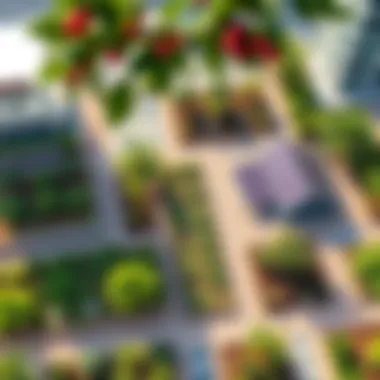

- Market Appreciation: Local property values are experiencing steady increases as demand rises for sustainable living spaces.
- Appeal to Buyers: Eco-conscious buyers are drawn to properties that reflect environmental values, indicating a shift in consumer behavior towards sustainable options.
- Regulatory Support: Government policies favoring green developments bolster the attractiveness of investments in Aldar, creating a supportive framework for growth.
This burgeoning real estate market is a strong indicator of the harmonious marriage between sustainability and economic prosperity.
Job Creation and Economic Growth
Lastly, Aldar Sustainable City is contributing to job creation, helping to invigorate the local economy in targeted ways. The job market thrives through various channels:
- Construction Employment: As buildings rise, so does the demand for skilled labor—including architects, engineers, and construction workers—fueling job opportunities on the ground.
- Green Sector Jobs: With the focus on sustainability, jobs related to renewable energy, waste management, and eco-friendly landscaping are becoming increasingly available.
- Service Sector Opportunities: As businesses flourish within Aldar, ancillary services such as retail, healthcare, and education inevitably grow, leading to further employment options.
This job creation is not just about numbers; it’s about fostering a sense of community, developing skills, and ensuring long-term economic stability for the residents of Aldar. In essence, Aldar Sustainable City is a masterclass in blending environmental consciousness with economic opportunity, proving that a commitment to sustainability can, indeed, bolster a thriving economy.
"Investing in sustainable cities is investing in a sustainable future; each dollar spent is a vote for the planet and its people."
For more information about sustainable urban practices, you can visit Wikipedia or explore additional insights on Britannica.
Keep your eyes open as Aldar continues to set a precedent for the future of urban planning and economic development.
Social Aspects of Aldar Sustainable City
The social dimension of Aldar Sustainable City plays a pivotal role in shaping a harmonious living environment. As the city emerges as a hub for sustainability, it’s essential to understand how social dynamics contribute to its overall effectiveness. This part of the overview dives into community engagement, education and awareness programs, and cultural integration. These elements are not mere additions; they form the backbone of community well-being and cohesion, fostering a sense of belonging among residents.
Community Engagement and Involvement
In any sustainable urban setup, community involvement is crucial. Aldar Sustainable City puts significant emphasis on inviting residents to participate in various aspects of city life. Here, initiatives are not just top-down mandates; they actively encourage grassroots participation.
Benefits of community engagement include:
- Strengthened social ties: When people come together to make decisions, it builds trust and cooperation.
- Feedback loops: Residents provide valuable insights into their needs and preferences, leading to more tailored services and amenities.
- Empowerment: Engaging communities makes them feel invested in their environment, which can ignite a sense of ownership over the city.
For example, Aldar often organizes community forums where residents can voice their opinions, and share experiences. These forums serve as a platform for discussions on local projects, environmental initiatives, and social concerns, ensuring everyone has a stake in the community.
Education and Awareness Programs
Education stands at the forefront of sustainable practices in Aldar Sustainable City. By enlightening residents about sustainability principles, the city is creating informed citizens who contribute to a greener future. Various educational programs are strategically designed to cater to all age groups, from children to adults.
Some noteworthy aspects of these programs include:
- Workshops and seminars: Covering topics like renewable energy, waste reduction, and water conservation.
- School programs: Integrating environmental education into school curriculums helps shape young minds with sustainability in focus.
- Resource centers: Establishing hubs where residents can access information about sustainable living and best practices encourages proactive measures among them.
The humble yet powerful impact of these programs highlights the ripple effect of knowledge sharing. Ultimately, educated residents contribute more significantly to sustainability goals, illustrating that awareness is a first step towards action.
Cultural Integration and Diversity
The fabric of Aldar Sustainable City is woven from the threads of diversity and multiculturalism. Recognizing the importance of cultural integration goes beyond mere coexistence—it's about celebrating differences and fostering unity. This city is a microcosm of UAE’s rich tapestry, and Aldar emphasizes the value of inclusivity.
Key focuses in this aspect include:
- Cultural events: Regularly hosting festivals and exhibitions that showcase various cultures encourages dialogues and connections among diverse groups.
- Shared public spaces: Designing communal areas that invite social interaction promotes cultural exchange. Places like parks and community centers become melting pots of ideas and traditions.
- Inclusive policies: Initiatives to ensure that all community members feel represented in decision-making processes.
"Aldar Sustainable City is the embodiment of how urban planning can celebrate diversity while embodying a commitment to sustainability."
By fostering a culture that values both sustainability and diversity, Aldar gives rise to a vibrant community that thrives on its rich social fabric. As it continues to engage, educate, and integrate, the city truly exemplifies how a social approach can magnify the impacts of sustainability efforts.
Challenges and Considerations
Navigating the intricate dance between development and environmental conservation is no small feat, particularly when it comes to projects like Aldar Sustainable City. These challenges not only shape the physical landscape but also influence the way communities interact with their environment. Understanding these obstacles is essential for stakeholders—whether they are investors, buyers, or developers—as they embark on endeavors that seek a harmony between progress and preservation.
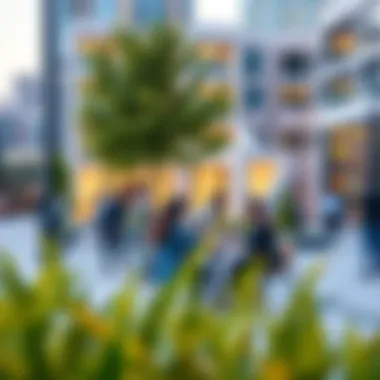

Balancing Development and Conservation
Aldar Sustainable City stands at the crossroads of urban expansion and ecological responsibility. Striking a balance between these two can often feel like trying to juggle watermelons. Developers have to keep a close eye on environmental impacts while still pushing for economic growth. For instance, integrating green spaces within urban plans isn’t just about aesthetics; it's about creating a livable environment that fosters community well-being.
Strategies to achieve this balance include:
- Incorporating extensive green areas that can cool urban heat islands, thereby mitigating climate change effects.
- Using sustainable drainage systems to manage stormwater while enhancing soil health and biodiversity.
- Incorporating wildlife corridors to maintain ecosystem connectivity, allowing native species to thrive even in developed areas.
This conscious consideration for nature encourages a more sustainable model that not only benefits the environment but also enhances property values and attracts conscientious buyers.
Regulatory and Policy Framework
Policies and regulations are the backbone that support sustainable development initiatives. Aldar Sustainable City must navigate a complex regulatory landscape that encompasses building codes, environmental legislation, and renewable energy mandates. While these rules could sometimes feel like a hurdle, they are essential for ensuring that development is both sustainable and safe.
To successfully operate within this framework, Aldar can:
- Engage in dialogues with governmental agencies to shape policies that encourage sustainable practices.
- Use technology to ensure compliance with energy efficiency standards, thus reducing operational costs in the long run.
- Advocate for streamlined permitting processes that reward environmentally friendly projects, making it easier and often cheaper to develop sustainably.
Taken together, these steps not only ensure regulatory compliance but also enhance Aldar's image as a forward-thinking entity committed to ecological integrity.
Global Economic Trends and Their Impact
As we look beyond the local context, understanding the ebb and flow of global economic trends is crucial for Aldar Sustainable City. Economic dynamics, such as changes in real estate demand or shifts toward sustainable investing, have direct ramifications on the city's development trajectory.
Specifically, trends like:
- The rising tendency of investors favoring green buildings, which have become a significant financial asset.
- Increasing global awareness of climate change, pressuring companies to adopt more sustainable practices.
- Fluctuating resources such as oil or raw materials that can affect construction costs and timelines.
By aligning with these trends, Aldar Sustainable City can position itself not just as a local leader, but as a participant in a global movement for sustainable urban living. Addressing these economic realities equips stakeholders with the tools needed to make informed decisions and embrace innovation.
The essence of Aldar Sustainable City is to shape a future where growth doesn’t come at the expense of the planet, offering a blueprint for success in the era of sustainability.
Future of Aldar Sustainable City
The evolution of Aldar Sustainable City is not just a vision for today but a blueprint for the future. As environmental challenges continue to loom large, the significance of developing sustainable urban spaces becomes increasingly evident. This section emphasizes the crucial role Aldar Sustainable City plays in leading by example, showcasing a commitment to ecological integrity while operating within the frameworks of economic growth and social well-being. Leveraging innovative practices, this initiative is poised to set a precedent in sustainable city design, attracting investors, buyers, and urban planners alike.
Long-Term Sustainability Goals
At the heart of Aldar Sustainable City lies its long-term sustainability goals. These goals are not mere aspirations but concrete strategies tailored to foster an environment where community and ecology flourish together. The key objectives include:
- Carbon Neutrality: Striving for a zero-carbon footprint by utilizing renewable energy sources, such as solar panels and wind turbines. The aim is to significantly minimize greenhouse gas emissions, making the city a pioneer in climate action.
- Biodiversity Enhancement: Incorporating green spaces and promoting local flora and fauna can improve urban biodiversity. The city plans parks and natural reserves that offer habitats for various species, enriching the urban ecosystem.
- Water Sustainability: With initiatives in place for rainwater harvesting and wastewater recycling, Aldar aims to create a closed-loop water usage system. This ensures ongoing availability of clean water while reducing dependency on external sources.
Adhering to these goals will be critical, as they not only address environmental concerns but also align with global sustainability trends — positioning Aldar as a model for future urban developments.
Innovations on the Horizon
Innovation serves as a cornerstone in the advancement of Aldar Sustainable City. As technology evolves, so do the potential solutions that can lead to a more sustainable urban lifestyle. Consider the following:
- Smart Infrastructure: Integrating Internet of Things (IoT) technologies can optimize energy consumption and improve residents' quality of life. Smart grids and intelligent traffic systems can reduce energy waste and commute times.
- Green Building Technologies: The city is looking into using advanced construction methods, including modular building and 3D printing, which can reduce material usage and speed up building times without compromising quality.
- Sustainable Transportation: Electric vehicle charging stations and extensive cycling paths are on their agenda. These alternatives can reduce reliance on fossil fuels while promoting a healthy lifestyle.
These innovations not only contribute to the city's sustainability goals but also entice potential investors, making Aldar Sustainable City a forward-thinking project with far-reaching implications.
Expanding the Sustainable Model
Expansion is vital for the long-term viability of Aldar Sustainable City, and it’s not limited to just the physical space but also the adoption of its sustainable model across different sectors and regions. Key strategies might include:
- Collaboration with Other Cities: Sharing best practices with similar urban projects globally can foster a culture of global sustainability. This can include partnerships with cities known for their green initiatives like Singapore or Copenhagen.
- Educational Programs: Providing resources and workshops to local communities about sustainable practices inspires action at individual levels. This grassroots movement can create a ripple effect, enhancing commitment to sustainability.
- Investment in Research and Development: By funding innovations in urban ecology and sustainability, Aldar could lead ongoing research projects that potentially revolutionize urban living.
"Sustainability is not a destination; it's a journey toward balance between living sustainably and thriving economy."
For more insight into sustainability and urban planning, check resources like Wikipedia, or visit Britannica.
Updates about sustainable living practices can also be found on Reddit and discussions on future cities may be explored on Facebook.




